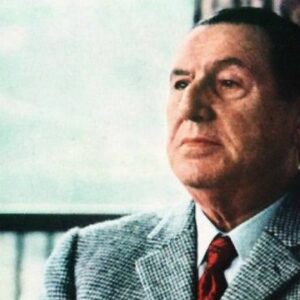Juan Domingo Peron was an Argentine lieutenant general who rose to prominence as Argentina’s President. Peron was born into a middle-class family, and while he struggled academically, he excelled athletically, which may have been one of the reasons he desired to join the Army. Peron spent many years in the Army, where he demonstrated his abilities as a teacher of military history at the academy. However, he later became a member of the group of army officers who staged the 1943 coup that overthrew the government of the day. Peron believed in social democracy and sought to ensure that Argentina’s blue collar workers received a fair deal from their employers. He worked to industrialize the country as quickly as possible and to repay foreign governments’ loans. Peron was deposed by another army faction and fled to exile, but returned to Argentina to reclaim the presidency. Peron is a defining figure in Argentina’s political history and is still revered by a large number of people throughout the country.
Childhood & Adolescence
Juan Domingo Peron was born on 8 October 1895 in Lobos, Argentina, to Mario Tomas Peron and Juana Sosa Toledo. His family originated in Sardinia, and his father ran his own sheep ranch in Argentina’s Patagonia.
Juan Peron was sent to a boarding school in Buenos Aires in 1904 for his education, where he excelled as an athlete and fencer. He was not particularly bright academically.
Juan Peron enrolled in the National Military College in El Palomar, Buenos Aires, at the age of sixteen and graduated two years later in 1913. Peron was appointed an infantryman and assigned to Parana, Entre Rios.
Career of Juan
Juan Peron joined the army at the age of 18, but quickly rose through the ranks, and in 1929, following a stint at the Superior War School, he accepted a position at the Army General Staff Headquarters. He was promoted to Major two years later and became a faculty member at the Superior War School.
Peron spent two years as the Military Attaché at the Argentine Embassy in Chile beginning in 1936 before traveling to Italy to study the intricacies of mountain warfare. He studied the Fascist regime in Italy and the Nazi regime in Germany during his time in Italy. Following this experience, Peron became convinced that social democracy could be the most effective form of government.
Peron was promoted to Colonel upon his return from Italy in 1941. Two years later, in 1943, as a member of the shadowy United Officers Group, Juan Peron became an active participant in the coup that deposed the country’s then-elected government, led by Ramon Castillo.
Juan Peron was appointed head of the Department of Labor following the coup. Peron was close to General Edelmiro J. Farrell, who served as de-facto President at the time. Peron was appointed Vice President and Secretary of War in 1944, retaining his Labour portfolio in the process.
As head of the Department of Labor, Juan Peron implemented a number of measures that were well received by blue collar workers. Along with introducing social benefits, he resolved a few labor disputes. When Juan Peron was imprisoned and stripped of his position in 1945 in a coup by another group of army officers, the labor unions revolted and he was released within days.
Juan Peron was inaugurated as Argentina’s President on 4 June 1946, following a campaign marred by military subjugation of his liberal opponents. Peron’s priorities were to industrialize Argentina and to provide greater economic security for the working class of the day. He nationalized the railways and also repaid a $1 billion loan to the Bank of England. His policies, however, put a strain on Argentina’s treasury.
Peron was re-elected President in 1951, but there was resentment within the Argentine Army, led by Eduardo Lonardi, about his vice-like grip on the country and the way he crushed liberal opposition.
Peron was deposed in a coup in 1955 and fled to Paraguay, eventually settling in Spain. Juan Peron spent his years in exile in Spain, and it was not until 1972 that he was permitted to return to his homeland, albeit for a brief period.
However, the following year, the Peronist Party won the election, and Peron was granted permanent residency in Argentina. He was elected President of Argentina the following year.
Significant Works of Juan
Juan Peron served as Argentina’s President for approximately 11 years over two terms, and his primary contribution during that time period was industrializing the country and ensuring that the economically disadvantaged segments of the Argentine workforce received the wages they deserved.
Personal History and Legacies
Juan Peron married Aurelia Tizon on 5 January 1929, but she died nine years later of uterine cancer. They were childless.
On 22 October 1945, Juan Peron married actress Eva Peron, better known as ‘Evita’. Eva Peron died in 1952, seven years later. They were childless.
Peron met singer and dancer Maria Estela Martinez, better known as Isabel, during his exile in Spain, and the two married in 1961.
Isabel became Argentina’s Vice President in 1973, when Peron assumed the presidency. Juan Peron died on 1 July 1974, at the age of 78, following multiple heart attacks.
Isabel succeeded him as President of Argentina and ruled for nearly two years, until she was deposed in a coup on 24 March 1976.
Estimated Net Worth
Juan is one of the wealthiest World Leaders and ranks high on the list of most popular World Leaders. Juan Domingo Perón’s net worth is estimated to be around $13 million, based on our analysis of Wikipedia, Forbes, and Business Insider.


